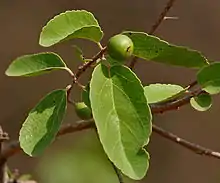Flacourtia indica
Flacourtia indica (known commonly as ramontchi, governor's plum and Indian plum, is a species of flowering plant native to much of Africa and tropical and temperate parts of Asia. It has various uses including, folk medicine, fuel, animal food and human food.
| Flacourtia indica | |
|---|---|
 | |
| Scientific classification | |
| Kingdom: | Plantae |
| Clade: | Tracheophytes |
| Clade: | Angiosperms |
| Clade: | Eudicots |
| Clade: | Rosids |
| Order: | Malpighiales |
| Family: | Salicaceae |
| Genus: | Flacourtia |
| Species: | F. indica |
| Binomial name | |
| Flacourtia indica | |
| Synonyms[2] | |
|
List
| |
Description
This is a bushy shrub or tree with a spiny trunk and branches. In shrub form it grows up to 25 feet (7.6 m) and as a tree it reaches a maximum height around 50 feet (15 m). The drooping branches bear oval leaves. The seeds are dispersed by birds.[3] This tree has thorns similar to that of a lime or lemon tree. If in contact with the thorns, it leaves a nasty stinging pain.
Taxonomy
It was first described and published in Interpr. Herb. Amboin. on page 377 in 1917.[2]
F. indica and Flacourtia ramontchi (the Madagascar plum) are treated as separate species, including by Plants of the World Online,[4][5][6] but not by GRIN (United States Department of Agriculture and the Agricultural Research Service).[7]
Uses
The ramontchi fruit itself is about an inch thick and red ripening purple. It is very fleshy and has 6 to 10 seeds in layered carpels. The pulp is yellow or white and sweet with an acidic tang. It is eaten raw or made into jelly or jam. It can be fermented to make wine.[8]
The leaves and roots are used in herbal medicine for treatment of snakebite. The bark is believed to be effective for arthritis. Most parts of the plant are used for cough, pneumonia, and bacterial throat infection. It has also been used for diarrhea.
In India, it is used in folk medicine to treat functional disorders like rheumatoid arthritis and gout. Its berries are edible and the bark can be triturated (ground) with sesamum oil and then used as alignment of rheumatism. Similarly, the extract of its fruit has diuretic, hepatoprotective, and antidiabetic properties (Patro et al. 2013).[9]
The tree is planted as a living fence; it was one of the species used for the Indian Inland Customs Line. The wood is used for firewood and small wooden tools such as plow handles.[8]
Distribution
It is native to the countries (and regions) of; Aldabra (Seychelles), Assam, Bangladesh, Botswana, Burundi, Cambodia, south eastern China, Comoros, Congo, Ethiopia, Hainan, India, Java, Kenya, Laccadive Islands, Laos, Lesser Sunda Islands, Madagascar, Malawi, Malaya, Mozambique, Myanmar, Namibia, Nepal, Pakistan, Philippines, Rwanda, Somalia, Sri Lanka, South Africa (in the Cape Provinces, KwaZulu-Natal and Northern Provinces), Sudan, Sulawesi, Tanzania, Thailand, Uganda, Vietnam, Zambia, Zaire and Zimbabwe.[2]
It has been introduced into various places such as; Angola, Bahamas, Chad, Dominican Republic, Hawaii, Jamaica, Leeward Islands, Mauritius, Nicobar Islands, Puerto Rico, (Island of) Réunion, Society Islands, Trinidad and Tobago.[2]
Cultivation
The plant is known as an occasionally invasive introduced species in some areas. It has been cultivated in Florida in the United States and today it occurs as a weed in some parts of the state.[10]
References
- Botanic Gardens Conservation International (BGCI) & IUCN SSC Global Tree Specialist Group (2019). "Flacourtia indica". IUCN Red List of Threatened Species. 2019: e.T146188176A146223268. doi:10.2305/IUCN.UK.2019-2.RLTS.T146188176A146223268.en. Retrieved 6 November 2022.
- "Flacourtia indica (Burm.f.) Merr. | Plants of the World Online | Kew Science". Plants of the World Online. Retrieved 26 October 2023.
- Pacific Island Ecosystems at Risk
- "Flacourtia ramontchi L'Hér. | Plants of the World Online | Kew Science". Plants of the World Online. Retrieved 26 October 2023.
- "Flacourtia ramontchi | ramontchi /RHS Gardening". www.rhs.org.uk. Retrieved 26 October 2023.
- "Flacourtia ramontchi L'Herit. | Species". India Biodiversity Portal. Retrieved 26 October 2023.
- "Flacourtia indica (Burm. f.) Merr". Germplasm Resources Information Network. Agricultural Research Service, United States Department of Agriculture. Retrieved 27 July 2016.
- World Agroforestry
- Patro, S.K.; Behera, P.C.; Kumar, P.M.; Sasmal, D.; Padhy, R.K.; Dash, S.K. (2013). "Pharmacological review of Flacourtia sepiaria (Ruxb.)". Scholars Academic Journal of Pharmacy. 2 (2): 89–93.
- "Flacourtia indica in Flora of North America @ efloras.org". www.efloras.org. Retrieved 2017-08-01.
